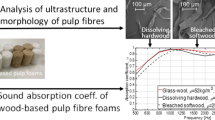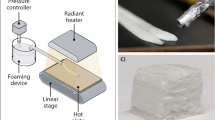Abstract
Design-driven process entailing iterative prototyping was used to develop foam-formed monomaterial structure made of renewable and recyclable biomaterials suitable e.g. for sound insulation in interior spaces. Interactions between wood-pulp fibres, the perforated mould and the forming process opened opportunities for multi-scale material design, which re-defined the direction of the research. This finding entailed the simultaneous formation of macroscopic 3D forms, surface textures, and micro-porous material structures. These multi-scale properties affected the material’s technical and perceptual qualities. The dyed pulp together with the multi-scale forms provided interesting variations in visual quality. Moreover, the surface texture enhanced the material’s tactile properties and gave a higher quality feel and enhanced rigidity.



(photo Eeva Suorlahti)






(photo Eeva Suorlahti)

(photo Eeva Suorlahti)

Similar content being viewed by others
References
Abernathy WJ, Utterback JM (1978) Patterns of industrial innovation. Technol Rev 80(7):40–47
Ackay O (2013) Product color choice and meanings of color: a case of Germany. Int J Bus Soc Sci 4:5–12
Alimadadi M, Uesaka T (2016) 3D-oriented fiber networks made by foam forming. Cellulose 23:661–671
Al-Qararah AM, Hjelt T, Kinnunen K, Beletski N, Ketoja JA (2012) Exceptional pore size distribution in foam-formed fiber networks. Nord Pulp Paper Res J 27:226–230
Al-Qararah AM, Hjelt T, Koponen A, Harlin A, Ketoja JA (2013) Bubble size and air content of wet fibre foams in axial mixing with macro-instabilities. Colloids Surf A Physicochem Eng Asp 436:1130–1139
Al-Qararah AM, Ekman A, Hjelt T, Ketoja JA, Kiiskinen H, Koponen A, Timonen J (2015) A unique microstructure of the fiber networks deposited from foam–fiber suspensions. Colloids Surf A Physicochem Eng Asp 482:544–553
Ashby MF, Johnson K (2010) Materials and design: the art and science of material selection in product design. Butterworth-Heinemann, Oxford
Ashby MF, Ferreira PJ, Schodek DL (2009) Nanomaterials, nanotechnologies and design. Butterworth-Heinemann, Boston
Driver A, Peralta C, Moultrie J (2011) Exploring how industrial designers can contribute to scientific research. Int J Des 5:17–28
Gibbons M, Limoges C, Nowotny H (1994) The new production of knowledge: the dynamics of science and research in contemporary societies. Sage, London
Haffner B, Dunne FF, Burke SR, Hutzler S (2017) Ageing of fibre-laden aqueous foams. Cellulose 24:231–239
Harlin A, Jetsu P, Heikkilä P, Kinnunen K (2013) Foam forming technology for tailored medical and hygienic applications. International Conference on Medical Textiles and Healthcare Products (MedTex13), Raleigh, NC, USA
Hellén E, Jetsu P, Lehmonen J (2013) Foam forming—What could it mean for tissue? Pap Technol 54:10–12
Heydarifard S, Nazhad MM, Xiao H, Shipin O, Olson J (2016) Water-resistant cellulosic filter for aerosol entrapment and water purification, Part I: production of water-resistant cellulosic filter. Environ Technol 37:1716–1722
Itälä J (2014) How design can contribute to materials research—explorative prototyping as a method for collaboration between design and materials science. Master’s Thesis. Aaltodoc. http://urn.fi/URN:NBN:fi:aalto-201410042685
Jäsberg A, Selenius P, Koponen A (2015) Experimental results on the flow rheology of fiber-laden aqueous foams. Colloids Surf A Physicochem Eng Asp 473:147–155
Karana E, Nijkamp N (2014) Fiberness, reflectiveness and roughness in the characterization of natural and high quality materials. J Clean Prod 68:252–260
Karana E, Hekkert P, Kandachar P (2008) Material considerations in product design: a survey on crucial material aspects used by product designers. Mater Des 29:1081–1089
Karana E, Hekkert P, Kandachar P (2009) Meanings of materials through sensorial properties and manufacturing processes. Mater Des 30:2778–2784
Karana E, Hekkert P, Kandachar P (2010) A tool for meaning driven materials selection. Mater Des 31:2932–2941
Khatri Z, Memon MH, Khatri A, Tanwari A (2011) Cold Pad-Batch dyeing method for cotton fabric dyeing with reactive dyes using ultrasonic energy. Ultrason Sonochem 18:1301–1307
Kiiskinen H, Juppi K, Timofeev O, Karlsson MA, Edelmann K (1999) Impingement drying of multi-ply linerboard. Pulp & Paper Canada, Brampton, pp T8–T10
Kinnunen K, Lehmonen J, Beletski N, Jetsu P, Hjelt T (2013) Benefits of foam forming technology and its application in high MFC addition structures. In: Proceedings of the 15th pulp and paper fundamental research symposium
Koponen A, Torvinen K, Jäsberg A, Kiiskinen H (2016) Foam forming of long fibers. Nord Pulp Paper Res J 31:239–247
Koponen A, Ekman A, Mattila K, Al-Qararah AM, Timonen J (2017) The effect of void structure on the permeability of fibrous networks. Transp Porous Med 117:247–259
Lehmonen J, Jetsu P, Kinnunen K, Hjelt T (2013) Potential of foam-laid forming technology in paper applications. Nord Pulp Pap Res J 28:392–398
Lewis DM (2014) Developments in the chemistry of reactive dyes and their application processes. Color Technol 130:382–412
Madani A, Zeinoddini S, Varahmi S, Turnbull H, Phillion AB, Olson JA, Martinez DM (2014) Ultra-lightweight paper foams: processing and properties. Cellulose 21(3):2023–2031
Miller E (1989) Textiles : properties and behaviour in clothing use. B. T. Batsford, London
Pöhler T, Jetsu P, Pääkkönen E, Lehmonen J, Kiiskinen H, Timofeev O, Torvinen K (2015) New 3D foam formed products. Proc PaperCon 2:1401–1409
Pöhler T, Jetsu P, Isomoisio H (2016) Benchmarking new wood fibre-based sound absorbing material made with a foam-forming technique. Build Acoust 23:131–143
Poranen J, Kiiskinen H, Salmela J, Asikainen J, Keränen J, Paakkonen E (2013) Breakthrough in papermaking resource efficiency with foam forming. ProcTAPPI PaperCon 1:807–814
Radvan B, Gatward APJ (1972) The formation of wet-laid webs by a foaming process. Tappi J 55:748–751
Schlünder EU (2004) Drying of porous material during the constant and the falling rate period: a critical review of existing hypotheses. Dry Technol 22:1517–1532
Silveira MT, Ferreira AGM, Lobo LQ (2002) The viscosity of aqueous suspensions of cellulose fibers part 1. Influence of consistency and fiber length. Silva Lusit 10:171–178
Stappers PJ (2006) Designing as a part of research. In: Proceedings of design and the growth of knowledge symposium, pp 13–17
Stokes DE (1997) Pasteur’s quadrant: basic science and technological innovation. Brookings Institution, Washington DC
Wilkes S, Wongsriruksa S, Howes P, Gamester R, Witchel H, Conreen M, Laughlin Z, Miodownik M (2016) Design tools for interdisciplinary translation of material experiences. Mater Des 90:1228–1237
Acknowledgments
This work was carried out under ‘Design Driven Value Chains in the World of Cellulose’, a multidisciplinary research project between VTT Technical Research Centre of Finland Ltd., Aalto University, Tampere University of Technology and the University of Vaasa. The project is funded by Tekes, the Finnish Funding Agency for Innovation. Sincere thanks also to Eeva Suorlahti for taking the photographs and Marjaana Tanttu for her help in the pulp dyeing.
Author information
Authors and Affiliations
Corresponding author
Appendix: Design-driven process
Appendix: Design-driven process
The research was executed through a design-driven iterative process. The cyclic iterations adjusted the direction of the research through the various development phases as new knowledge was brought to light. The process was flexible in nature, and thus the course and even goals of the research could be clarified and changed as the work progressed. The point was not to establish a fixed hypothesis or point of view from the outset. Rather, learning took place through doing, and the process and prototypes themselves opened up new interesting research trajectories.
The iterative design-driven process included the following phases (Fig. 12):
This diagram represents the stages and sequences of the design-driven iterative process used in the research. The numbers represent the key phases of the process, such as the designing and testing of prototypes. The loops highlight the iterative nature of the process. For example, the production of a prototype brings forth new information that urges the process a few steps back, for re-adjusting the approach based on the newly acquired information. The various phases are explained in the text below
-
1.
Defining an acoustic interior element as the driving application for the research The first task was to find an example application to guide the prototyping. An acoustic interior building panel was considered ideal in terms of the material, the foam forming process and the design-driven approach.
-
2.
Designing a rectangular shaped panel with smooth contours Moulding of smooth forms was chosen, as this was expected to be less challenging than forms with sharp angular features. The panel design incorporated two round elevations of different heights to test the moulding of different radii.
-
3.
Prototyping the rectangular panel with a plywood mould and white pulp Drying was enhanced by removing water through the holes in the female part by vacuum and by applying additional pressure with the male part, which resulted in quite a dense fibre-network structure. The two elevations on the panel did not form equally well: the higher formed much better than the lower. The plywood mould also broke midway through the testing. The prototyping thus had limited success.
-
4.
Designing a triangular shaped panel with smooth contours The design was changed to have steeper forms with tighter radii for inspecting moulding limits. All four “ridges” of the form were equally high, in order to avoid moulding problems with forms of varying heights. Again, the mould consisted of two parts, but this time it was first made out of gypsum to avoid disintegration due to moisture.
-
5.
Prototyping the triangular panel with a gypsum mould and dyed pulp The moulding of the material succeeded better than with the first mould. However, the gypsum mould absorbed moisture. This significantly slowed the drying of the formed material, which was kept between the male and female moulds to minimize material shrinkage.
-
6.
Prototyping the triangular panel with a polystyrene mould and dyed pulp A densely perforated polystyrene mould was produced to speed drying of the prototype and make the mould lighter and moisture durable. The dense perforation of the mould with its sub-millimetre sized holes was copied during the moulding onto the prototype forming a regular surface texture. At this point the potential of a multi-scale moulding approach was realized.
-
7.
Designing the V-pleat shaped panel with angular contours The design was created to study moulding of sharper and more angular forms. The male part of the mould was omitted, and thus forming took place solely by drainage through the female mould. This resulted in thicker prototypes.
-
8.
Prototyping the V-pleat panel with a rib-weave wire-gauze mould and dyed pulp The mould was made from rib-weave wire gauze to examine its effect on the prototype’s surface texture. The mould created a densely perforated structure that enabled quick water removal, good moisture durability and a dense texture on the material surface.
-
9.
Prototyping the V-pleat panel with a 3D-printed PLA mould and dyed pulp The 3D-printed mould was tested to see whether the use of a low-resolution print would allow water leakage through the small gaps between the print paths. The mould worked well and there were no problems with drainage. There was no noticeable surface texture in the final material structure.
-
10.
Designing planar moulds used for surface texture experiments Eleven different planar moulds were prepared containing perforations of varying size, density and shape. The holes were located on a square lattice. The relative penetration area varied between 13 and 44% depending on the geometry. The smallest area (16%) was obtained by three different geometries as shown in Table 2, which allowed estimation of the importance of geometry details in texture formation.
-
11.
Prototyping surface textures using laser cut and 3D printed planar moulds and white pulp The planar sheets worked well for studying the moulding of the surface textures.
Rights and permissions
About this article
Cite this article
Härkäsalmi, T., Lehmonen, J., Itälä, J. et al. Design-driven integrated development of technical and perceptual qualities in foam-formed cellulose fibre materials. Cellulose 24, 5053–5068 (2017). https://doi.org/10.1007/s10570-017-1484-6
Received:
Accepted:
Published:
Issue Date:
DOI: https://doi.org/10.1007/s10570-017-1484-6





